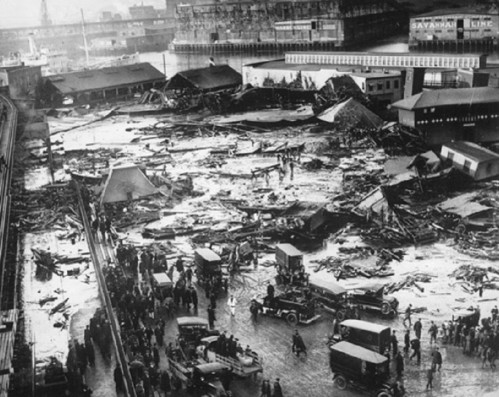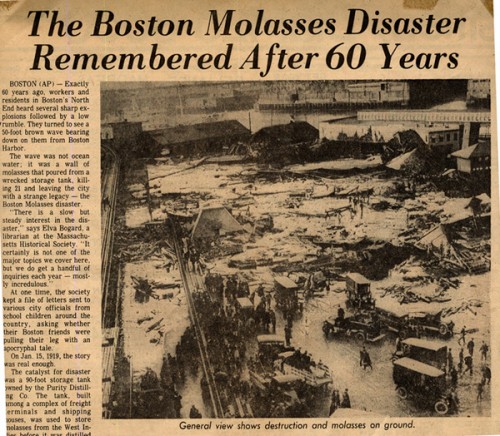also known as the Great Molasses Flood and the Great Boston Molasses Tragedy, occurred on January 15, 1919, in the North End neighborhood of Boston, Massachusetts in the United States. A large molasses tank burst, and a wave of molasses rushed through the streets at an estimated 35 mph (56 km/h), killing 21 and injuring 150. The event has entered local folklore, and residents claim that on hot summer days, the area still smells of molasses.[1]
The disaster occurred at the Purity Distilling Company facility on January 15, 1919, an unusually warm day. At the time, molasses was the standard sweetener in the United States. Molasses can also be fermented to produce rum and ethyl alcohol, the active ingredient in other alcoholic beverages and a key component in the manufacturing of munitions at the time.[2] The stored molasses was awaiting transfer to the Purity plant situated between Willow Street and what is now named Evereteze Way in Cambridge, Massachusetts.
Near Keany Square,[3] at 529 Commercial Street, a huge molasses tank 50 ft (15 m) tall, 90 ft (27 m) in diameter and containing as much as 2,300,000 US gal (8,700,000 L) collapsed. Witnesses stated that as it collapsed, there was a loud rumbling sound like a machine gun as the rivets shot out of the tank, and that the ground shook as if a train were passing by.[4]
The collapse unleashed an immense wave of molasses between 8 and 15 ft (2.5 to 4.5 m) high, moving at 35 mph (56 km/h), and exerting a pressure of 2 ton/ft² (200 kPa).[5] The molasses wave was of sufficient force to break the girders of the adjacent Boston Elevated Railway\’s Atlantic Avenue structure and lift a train off the tracks. Nearby, buildings were swept off their foundations and crushed. Several blocks were flooded to a depth of 2 to 3 feet (60 to 90 cm). As described by author Stephen Puleo,
Molasses, waist deep, covered the street and swirled and bubbled about the wreckage. Here and there struggled a form — whether it was animal or human being was impossible to tell. Only an upheaval, a thrashing about in the sticky mass, showed where any life was… Horses died like so many flies on sticky fly-paper. The more they struggled, the deeper in the mess they were ensnared. Human beings — men and women — suffered likewise.[6]
The Boston Globe reported that people “were picked up by a rush of air and hurled many feet.” Others had debris hurled at them from the rush of sweet-smelling air. A truck was picked up and hurled into Boston Harbor. Approximately 150 were injured; 21 people and several horses were killed — some were crushed and drowned by the molasses. The wounded included people, horses, and dogs; coughing fits became one of the most common ailments after the initial blast.
Anthony di Stasio, walking homeward with his sisters from the Michelangelo School, was picked up by the wave and carried, tumbling on its crest, almost as though he were surfing. Then he grounded and the molasses rolled him like a pebble as the wave diminished. He heard his mother call his name and couldn\’t answer, his throat was so clogged with the smothering goo. He passed out, then opened his eyes to find three of his sisters staring at him.[1]









That’s some crazy sh!t right there, boy.
I wonder if anyone had waffles.
See also:
en.wikipedia.org/wiki/London_Beer_Flood
Now that’s what I call too sweet. YEEAAAAHHH!
Wall of text.
is not 🙂
Holy crap!
70 years later a fateful child was born (me)… wow, something this big happened on my birthday long ago…
On a hot day in the North End, you can still smell the molasses.